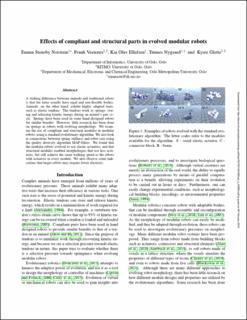| dc.contributor.author | Norstein, Emma Stensby | |
| dc.contributor.author | Veenstra, Frank | |
| dc.contributor.author | Ellefsen, Kai Olav | |
| dc.contributor.author | Nygaard, Tønnes | |
| dc.contributor.author | Glette, Kyrre | |
| dc.date.accessioned | 2024-02-15T07:57:47Z | |
| dc.date.available | 2024-02-15T07:57:47Z | |
| dc.date.created | 2023-12-07T08:35:16Z | |
| dc.date.issued | 2023 | |
| dc.identifier.uri | https://hdl.handle.net/11250/3117876 | |
| dc.description.abstract | A striking difference between animals and traditional robots is that the latter usually have rigid and non-flexible bodies. Animals, on the other hand, exhibit highly adapted traits, such as elastic tendons. The tendons work as springs, storing and releasing kinetic energy during an animal’s gait cycle. Springs have been used in some hand designed robots for similar benefits. However, little research has been done on springs in robots with evolving morphology. We examine the use of compliant and structural modules in modular robots, using a standard evolutionary algorithm. We also look at connections between spring stiffness and robot size using the quality diversity algorithm MAP-Elites. We found that the modular robots evolved to use elastic actuators, and that structural modules enabled morphologies that use less actuators, but still achieve the same walking speed as the robots with actuators in every module. We also observe some indications that larger robots may require lower elasticity. | en_US |
| dc.language.iso | eng | en_US |
| dc.publisher | MIT Press | en_US |
| dc.relation.ispartof | ALIFE 2023: Ghost in the Machine: Proceedings of the 2023 Artificial Life Conference | |
| dc.rights | Navngivelse 4.0 Internasjonal | * |
| dc.rights.uri | http://creativecommons.org/licenses/by/4.0/deed.no | * |
| dc.title | Effects of compliant and structural parts in evolved modular robots | en_US |
| dc.type | Chapter | en_US |
| dc.type | Peer reviewed | en_US |
| dc.type | Conference object | en_US |
| dc.description.version | publishedVersion | en_US |
| cristin.ispublished | true | |
| cristin.fulltext | original | |
| cristin.qualitycode | 2 | |
| dc.identifier.doi | https://doi.org/10.1162/isal_a_00689 | |
| dc.identifier.cristin | 2210082 | |
| dc.relation.project | Norges forskningsråd: 262762 | en_US |
| dc.relation.project | Sigma2: NN9740K | en_US |

